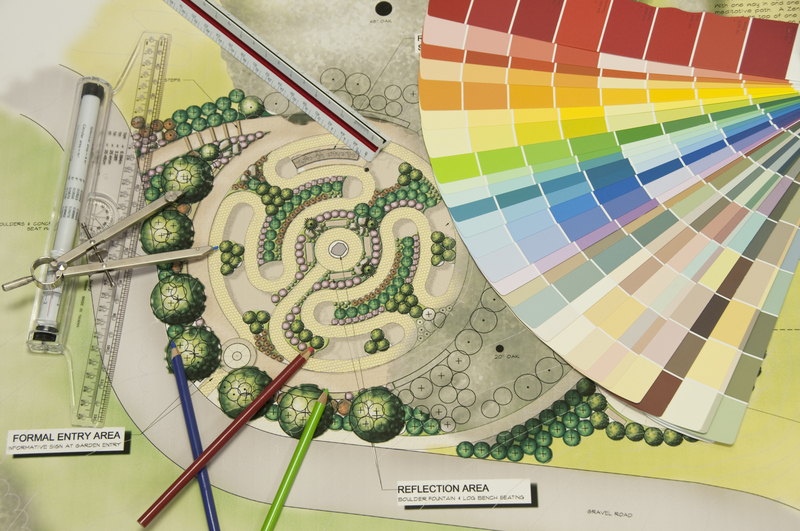Crafting a Peaceful Escape with Zen Garden Designs
Posted on 29/05/2025
Crafting a Peaceful Escape with Zen Garden Designs
Are you dreaming of a serene spot where the stresses of daily life melt away? By crafting a Zen garden design, you can transform even the smallest space into a harmonious retreat that soothes the mind, body, and spirit. Whether you have a sprawling backyard or a tiny apartment balcony, embracing the principles of Zen garden design can infuse your environment with tranquility and mindfulness. In this comprehensive guide, discover how to design a peaceful Zen garden escape, delve into its ancient philosophy, and explore practical steps for every budget and space.

Understanding the Essence of Zen Gardens
Zen gardens, or Japanese rock gardens (karesansui), originated in Japan during the Muromachi period (1336-1573). They were designed by Buddhist monks as places for contemplation and meditation. Rather than relying on lush greenery or ornate decorations, these gardens use simple elements--rocks, gravel, sand, and a few carefully selected plants--to evoke the essence of nature.
- Symbolism: Rocks represent islands or mountains, while raked sand or gravel symbolizes water or flowing streams.
- Simplicity: Minimalistic arrangements foster focus and calmness.
- Mindfulness: The act of raking patterns in sand becomes a meditative exercise.
Creating your own peaceful Zen retreat encourages mindfulness, deep relaxation, and a renewed connection with nature. Today, people worldwide are inspired by these calming landscapes to craft personal sanctuaries, both indoors and out.
Why Choose a Zen Garden for Your Escape?
With modern life becoming increasingly hectic, the need for peaceful spaces has never been greater. Designing a Zen garden offers several unique benefits:
- Stress Relief: The tranquil arrangement of natural elements calms the mind.
- Low Maintenance: Unlike traditional gardens, Zen gardens require minimal upkeep.
- Year-Round Appeal: Zen designs are attractive in all seasons, regardless of climate.
- Versatility: Suitable for indoor, courtyard, or outdoor settings of any size.
- Mindful Living: Promotes meditation, reflection, and mindful habits.
Whether you're an urban dweller or countryside enthusiast, Zen garden design ideas can be adapted to your unique surroundings.
Key Elements of Zen Garden Designs
To master the art of Zen garden landscaping, it's essential to understand the basic components and their meanings:
1. Rocks and Stones
Rocks are the backbone of any Zen garden, symbolizing mountains, islands, or ancient landscapes. Select stones that differ in size, shape, and color for a natural appearance, and arrange them in odd numbers to create a feeling of organic balance.
2. Sand or Gravel
Often called the "sea" of the Zen garden, raked sand or gravel symbolizes water and movement. Use a wooden rake to create flowing wave patterns. This meditative activity encourages mindfulness and fosters a sense of continually 'refreshing' your space.
3. Moss and Ground Covers
A touch of moss, creeping thyme, or other low-growing ground covers adds softness and a lush, lived-in feel. Moss is particularly valued in traditional Japanese Zen gardens for its vivid green hue and connection to ancient, untouched nature.
4. Minimalist Plantings
Choose subtle, sculptural plants such as bamboo, Japanese maple, or compact evergreens. These plants contribute to the garden's meditative look and evoke changing seasons without overwhelming the senses.
5. Ornaments and Features
- Lanterns: Symbolize wisdom and illumination.
- Bridges: Represent journeys of self-discovery.
- Basins & Bamboo Fountains (Tsukubai): Add gentle motion and sound, enhancing tranquility.
Tip: Use ornaments sparingly--each piece in a Zen garden design should serve a purpose and blend harmoniously with the overall composition.
A Step-by-Step Guide to Crafting Your Own Zen Garden Escape
Ready to create your own sanctuary? Follow these expert steps for designing a Zen garden that brings relaxation and beauty to your home.
Step 1: Choose the Right Site
- Pick a location that encourages quiet contemplation--preferably away from daily distractions.
- For small spaces, a corner of your yard, patio, deck, or even a tabletop can suffice.
Step 2: Sketch Your Layout
- Draw out your ideas, considering rock placements, plant choices, and sand areas.
- Keep the design minimalist; the "less is more" ethos underpins every authentic Zen landscape.
Step 3: Prepare the Base
- Clear the site of weeds, grass, and debris.
- Lay a weed barrier or a layer of landscape fabric to prevent unwanted growth.
- Outline the borders with edging stones, wood, or bamboo fencing.
Step 4: Arrange Rocks & Features
- Start with the largest rocks, placing them asymmetrically for a natural look.
- Add smaller stones and balance with minimal ornaments or garden features.
Step 5: Add Gravel or Sand
- Pour a layer of fine gravel or sand to a depth of 2-3 inches.
- Use a claw rake or homemade wooden rake to create swirling or parallel lines, emulating water currents.
Step 6: Incorporate Plantings
- If space allows, plant moss, Japanese maple, or dwarf bamboo.
- Keep greenery understated to maintain the Zen-like atmosphere.
Step 7: Add Final Touches
- Introduce a stone lantern, water basin, or bamboo water spout for delicate beauty.
- Step back, observe from various angles, and make adjustments as needed to balance all elements.
Zen Garden Design Variations for Every Space
Not every home has sprawling gardens, but the joy of Zen-inspired landscaping is its flexibility. Here are several popular variations:
Miniature Tabletop Zen Gardens
- Perfect for offices, bedrooms, or meditation nooks.
- Use a shallow tray, a handful of sand, a few pebbles, and a miniature rake.
- Ideal for stress relief and daily mindfulness breaks.
Urban Zen Retreats
- Transform your balcony or rooftop with potted bamboo, stone containers, and sand-filled planters.
- Incorporate water features for calming ambient sounds.
Courtyard Zen Oases
- Frame a small courtyard with gravel rivers, stepping stones, and minimal shrubbery.
- Screen the area with wooden fencing or bamboo for privacy.
Tips to Enhance Tranquility in Your Zen Garden Escape
- Limit Your Palette: Stick with natural colors and materials--avoid plastic, bright flowers, or flashy ornaments.
- Embrace Imperfection: Slight asymmetry and weathered stones evoke the Japanese concept of wabi-sabi (beauty in imperfection).
- Encourage Meditation: Create a comfortable seating spot--perhaps a low bench or flat rock--for moments of reflection.
- Balance Light and Shadow: Use leafy plants or lattice for dappled light, enhancing the sense of peace.
- Keep It Uncluttered: Regularly remove debris, prune gently, and re-rake gravel to maintain order and harmony.
Maintaining Your Zen Garden
To preserve the tranquil ambiance you've created, adopt a gentle maintenance routine:
- Rake Patterns Frequently: This meditative activity renews the design while keeping gravel pristine.
- Weed Regularly: Promptly remove any unwanted growth that might spoil the minimalist look.
- Trim Plants: Shape bamboo, moss, or shrubs as needed to keep things in proportion.
- Clean Water Features: If you include a fountain or basin, ensure water stays clean and fresh.
Incorporating Zen Garden Principles Indoors
No yard? No problem! Japanese Zen garden design can be adapted to interior spaces:
- Use a shallow dish or tray with fine sand and tiny pebbles for an office or living room accent.
- Group a few bonsai, moss arrangements, or bamboo stalks near windows for a green, calming effect.
- Add small water fountains for the peaceful sound of trickling water indoors.
Even the smallest indoor Zen display can invite moments of mindful pause and calm reflection through your day.
Zen Garden Designs: Common Mistakes to Avoid
- Overcrowding with Ornaments: More is not better--a few well-placed accents create calm, not clutter.
- Choosing Incompatible Plants: Stick to shade-tolerant, slow-growing greenery for authentic results.
- Neglecting Symbolism: Each item should have a purpose and be thoughtfully placed.
- Ignoring the Surroundings: Blend your Zen garden into its environment with sensitive placement and natural edges.

Frequently Asked Questions About Zen Garden Escapes
How much space do I need for a Zen garden?
Zen gardens are highly adaptable. You can create a calming escape with just a tabletop or dedicate an entire backyard, depending on your preference and available area.
Are Zen gardens expensive to build?
With an emphasis on minimalism and natural materials, Zen gardens are typically budget-friendly. Choose local stones, upcycle containers, or repurpose old rakes for a thrifty solution.
What plants are best for Zen gardens?
Popular choices include moss, ferns, dwarf bamboo, Japanese forest grass, and Japanese maples. Select slow-growing, low-maintenance species for long-lasting beauty.
Can Zen gardens work in dry climates?
Absolutely! Rely on rock arrangements, gravel, and drought-tolerant plants to evoke a Zen garden design that is both serene and sustainable.
Conclusion: Your Tranquil Zen Garden Awaits
In today's fast-paced world, crafting a peaceful escape with Zen garden designs is a timeless gift to yourself--promoting balance, peace, and clarity. With these ideas, tips, and inspiration, you can embark on your journey to create a unique tranquil haven, whether outdoors or indoors. Remember that the true beauty of a Zen garden lies in its simplicity and the sense of calm it brings to life's chaos. Start planning your Zen-inspired garden escape today, and experience the rewards of mindful, harmonious living!

